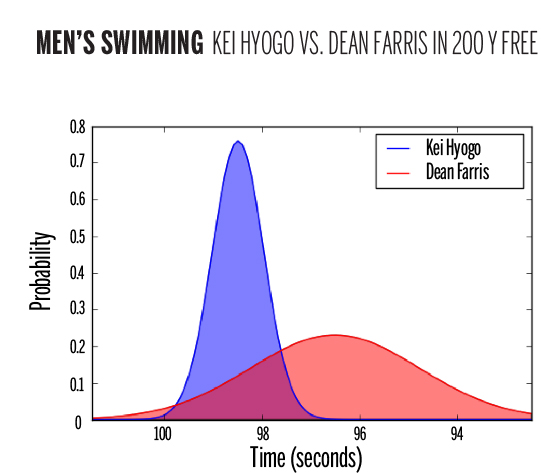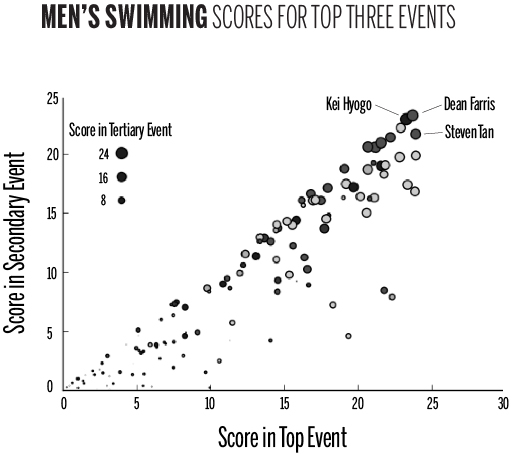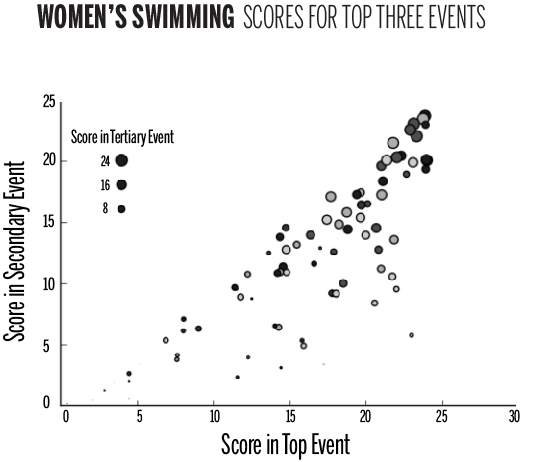
On the surface, swimming appears to be one of the simplest sports in which to evaluate athlete value. By comparing the set of times posted by two swimmers for an event over the course of the season, we can determine with high certainty which swimmer would triumph in a one-on-one race. Furthermore, to evaluate an athlete’s impact on the team, we can just take the sum of the points he or she has contributed across the course of the season. There is reason to believe, however, that these simple metrics may not give the full picture.
In the Yale men’s swimming and diving team’s meet against Cornell on Jan. 22, the top-three finishers in the 100-meter freestyle were separated by only 0.4 seconds in a 46-second race. The winner, Cornell’s Jack Mahoney, has logged times over the course of the season between 1.5 seconds faster and a full second slower than his 46.03-second mark against the Bulldogs. If that race were to be run again, we might indeed see a different result.
In assessing athlete value, we want to avoid overvaluing very close wins, as these are often the result of randomness rather than consistent skill. Our first chart shows the probability distribution for two of Yale’s and Harvard’s best swimmers for the 200-meter freestyle. We can see that the Crimson’s Dean Farris has a faster mean time, but also a much higher standard deviation, than the Elis’ Kei Hyogo ’18. Due to this higher variance, we can predict that Hyogo could beat Farris as much as 14 percent of the time in this race, even though Farris swims nearly two seconds faster than Hyogo on average.
To take the variability of swimming performances into account, we use a simulation-based model to build a metric of swimmer value. For each swimmer in the Ivy League, we computed the mean and variance of their times in each event for the 2016–17 season. We then performed 10,000 simulations of a theoretical meet in which all swimmers race their five best events and the top-24 finishers in each event are awarded points. Finally, we took the sum across all events to give each swimmer a value score.
Our analysis lists Hyogo, Farris and Harvard’s Koya Osada as the top-three men’s swimmers in the Ivy League, with Jonathan Rutter ’18 also representing the Bulldogs in the top 10 at number eight. The Bulldogs’ Aaron Greenberg ’18 ranks 13th in our rankings, faring worse than his teammate because he competes primarily in the 50-yard freestyle and 100-yard freestyle without a consistent third event.
The chart below displays the scores for each male swimmer in their best, second-best and third-best event. The best swimmers across three events are represented by large bubbles in the top right of the graph.

From this chart, we can see that the best swimmers in the Ancient Eight tend to excel in several events, and only a few fall far below the diagonal, which comprises swimmers with small differences between their top two events.
We also repeated our analysis for women’s swimming. Here, the top-three competitors in our metric are Harvard’s Miki Dahlke and Claire Pinson and Columbia’s Mary Ashby. For the women, the cluster in the top left of our top-three-events chart is much denser, demonstrating more parity at the top of the ranks.

Yale’s top-scoring female swimmers are Lili Margitai ’20, Kina Zhou ’17 and Destiny Nelson ’19, coming in at eighth, 12th and 15th, respectively. The undefeated female Bulldogs have 11 swimmers in the top 50, bested only by the one-loss Harvard team with 12.







